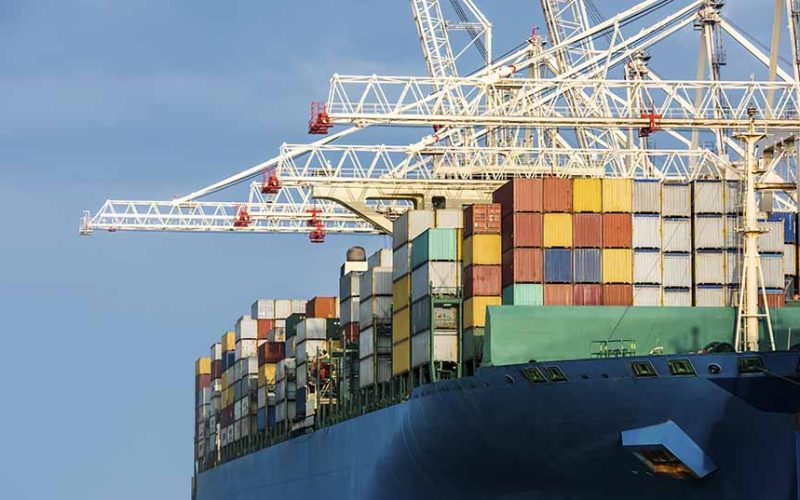by Jeffrey Kleintop, CFA®, Managing Director, Chief Global Investment Strategist, Charles Schwab & Co., Inc.
The "end of globalization" is a phrase that has come up a lot lately. Stories written about deglobalization have hit a fevered pitch with the war in Ukraine. But they began to heat up six years ago as that summer's Brexit referendum resulted in the British voting to leave the European Union. As you can see in the chart of "deglobalization" appearing in major news stories below, authors have attributed the potential end of world trade growth to:
- Brexit in 2016;
- President Trump's trade policy in 2017;
- The rise of Nationalism in 2018;
- The pandemic in 2020;
- The war in Ukraine in 2022.
Yet, none of these have led to a decline in world trade. In fact, global trade hit a new all-time high this year after climbing steadily throughout the past six years despite the brief "V"-shaped disruption in response to the pandemic lockdowns.
Hot topic

Source: Charles Schwab, CPB Netherlands Bureau for Economic Policy Analysis, Bloomberg data and news search of major publications as of 4/8/2022.
Politics vs. economics
For decades, globalization described an economic concept, but more recently it has become blurred with a political concept. Separating the two ideas is important to understand the impact on investors.
Now, making such a distinction may not apply to Russia, since the country has decoupled from the rest of the world both politically and economically. But that is the exception. The U.S. and China, who have seen significant political decoupling, remain tightly intertwined economically. Brexit was primarily a political decoupling of the U.K. from the EU, not an economic one—as highlighted by U.K. imports from the EU recently hit their second-highest-ever level in January 2022 (the latest data point available). Even though the pandemic prompted politicians in major economies to tout new sources of domestic supplies of goods deemed essential, the trends in cross-border trade in vaccines, personal protection equipment, and ventilators remain largely unaltered.
Despite the political deglobalization, we've seen no pickup in new construction of domestic manufacturing facilities to allow for economic deglobalization. The U.S. has seen no growth in such spending in either dollars or as a percentage of GDP even as the stories of the end of globalization piled up in recent years. As you can see in the chart below, spending on the construction of new manufacturing facilities has remained rangebound between $5 and $8 billion since 2015.
How would more domestically made goods be produced?

Source: Charles Schwab, U.S. Census Bureau data retrieved from Bloomberg as of 4/9/2022.
Measuring trade
Some would argue that the value of world trade was stalling prior to the pandemic. When focusing on the economics of globalization it is important to look at the volume of global trade, since the value of trade can be impacted by many factors that can be misleading. The chart below shows that world trade momentum measured in dollars appeared to stall from 2008 through 2020, even as the volume of trade advanced steadily.
World trade volume vs. value

Source: Charles Schwab, Bloomberg data as of 4/9/2022.
We don't believe that politics stalled the dollar value of trade. Overall, tariffs and non-tariff barriers to global trade were lowered, not raised, according to actions tracked by the World Trade Organization. In fact, the dollar amount of world trade rose 21% during the Trump administration from January 2017 to January 2021, rebounding from the oil-related downturn in 2015-16, and then surged during the pandemic.
There were two major causes of the stall in the U.S. dollar value of global trade growth from 2008-2020:
- The oil market acted as a drag on global trade. Fuel made up 16% of global exports in 2008 and fell to just 11% in 2019, before the pandemic. This 5% drop in oil trade took place as world growth became less dependent on fossil fuels and U.S. oil supply rose and eliminated the country's dependence on fuel imports (which once made up nearly half of the U.S. trade deficit).
- When measuring global trade in U.S. dollars, the appreciation of the dollar weighs on the dollar value of trade, independently of the unit volume. Merchandise trade volume grew 17% from January 2008 to January 2020, according to the widely watched World Trade Monitor, prepared by the Netherlands Bureau of Economy Policy Analysis. But when observing trade by value, a rising dollar appeared to erase that gain. The broad trade-weighted value of the U.S. dollar rose 35%, from 95 to 128, from mid-2008 to the end of 2019.
As a result of these distortions, looking at world trade volume instead of its dollar value tends to be more insightful in identifying the trend in globalization.
Globalization evolves
The idea of economic globalization defined as the sourcing of production in one country with the lowest labor cost and exporting the final product to be sold everywhere else is now outdated. With the advances in robotics and other manufacturing technology, labor has a smaller cost input to manufactured products. Equipment miniaturization and localization of manufacturing has allowed for multiple redundant supply chains as well as local customization for products sold around the world, generating profits for companies independent of where they are headquartered. Sales and profits remain globalized even as the goods being sold may rely less on cross-border transportation.
The rapidly growing digital economy takes globalization even further. Services were once hard to export, and goods made up the vast bulk of international trade. But now, cross-border data traffic is exploding and services such as software, apps, video games, music, and video can all be produced and distributed virtually anywhere.
Those who view globalization from only a political perspective may be surprised. Future developments in drivers of economic globalization may have different impacts:
- Countries seeking domestic renewable energy supplies may act as a drag on global trade in energy resources, but global sourcing of green technologies being adopted may be a potentially significant offset. As an example, the MSCI Alternative Energy Index is made up of producers of green energy solutions from around the world (ex. U.S. 32%, Denmark 21%, China 16%, Canada 6%, India 4%).
- The localization and vertical integration of supply chains within emerging-market economies has likely reduced some cross-border trade in intermediate goods. What this means is that a larger portion of overall supply chains are falling within one country moreso than in the past, and therefore products cross borders fewer times during the manufacturing process. The impact of these business decisions can be observed by the falling share of intermediate goods exports relative to final goods exports, especially in China. Yet, this may be offset by scope for a finer division of supply chains in frontier markets like Africa, South America, and less-developed parts of Asia.
- Ultimately, history shows that global trade grows in sync with global economic growth. It pulls back in recessions and grows during expansions.
Of course, there will also be other unknown factors yet to emerge and influence the trend in global trade.
Does it matter?
The political deglobalization taking place in recent years might not matter that much to investors. It didn't result in a stall in the sales of multinational companies nor a decline in the international portion of those sales. As overall sales have climbed, the international share has remained consistent at around 40% for companies in the U.S. and Europe and around 55% for companies in Japan, according to data from FactSet.
Percentage of sales generated internationally

Share of domestic sales for S&P 500 and MSCI Japan Index and share of European region sales for MSCI Europe Index per FactSet GeoRev data.
Source: Charles Schwab, FactSet data as of 4/8/2022.
Political deglobalization could lead to some reshoring of industries deemed essential and some companies linked to national security issues may be impacted. But political deglobalization may have little impact on economic globalization or corporate profits—the main driver for stock market returns over the long-term. This likely means there is little reason for investors to deglobalize their portfolios, despite the headlines.
Michelle Gibley, CFA®, Director of International Research, and Heather O’Leary, Senior Global Investment Research Analyst, contributed to this report.
Copyright © Charles Schwab & Co., Inc.














